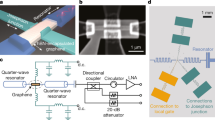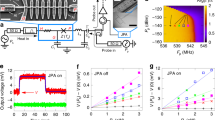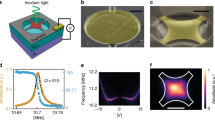Abstract
Radiation sensors based on the heating effect of absorbed radiation are typically simple to operate and flexible in terms of input frequency, so they are widely used in gas detection1, security2, terahertz imaging3, astrophysical observations4 and medical applications5. Several important applications are currently emerging from quantum technology and especially from electrical circuits that behave quantum mechanically, that is, circuit quantum electrodynamics6. This field has given rise to single-photon microwave detectors7,8,9 and a quantum computer that is superior to classical supercomputers for certain tasks10. Thermal sensors hold potential for enhancing such devices because they do not add quantum noise and they are smaller, simpler and consume about six orders of magnitude less power than the frequently used travelling-wave parametric amplifiers11. However, despite great progress in the speed12 and noise levels13 of thermal sensors, no bolometer has previously met the threshold for circuit quantum electrodynamics, which lies at a time constant of a few hundred nanoseconds and a simultaneous energy resolution of the order of 10h gigahertz (where h is the Planck constant). Here we experimentally demonstrate a bolometer that operates at this threshold, with a noise-equivalent power of 30 zeptowatts per square-root hertz, comparable to the lowest value reported so far13, at a thermal time constant two orders of magnitude shorter, at 500 nanoseconds. Both of these values are measured directly on the same device, giving an accurate estimation of 30h gigahertz for the calorimetric energy resolution. These improvements stem from the use of a graphene monolayer with extremely low specific heat14 as the active material. The minimum observed time constant of 200 nanoseconds is well below the dephasing times of roughly 100 microseconds reported for superconducting qubits15 and matches the timescales of currently used readout schemes16,17, thus enabling circuit quantum electrodynamics applications for bolometers.
This is a preview of subscription content, access via your institution
Access options
Access Nature and 54 other Nature Portfolio journals
Get Nature+, our best-value online-access subscription
$29.99 / 30 days
cancel any time
Subscribe to this journal
Receive 51 print issues and online access
$199.00 per year
only $3.90 per issue
Buy this article
- Purchase on Springer Link
- Instant access to full article PDF
Prices may be subject to local taxes which are calculated during checkout



Similar content being viewed by others
Data availability
Data supporting the findings of this study are available at https://zenodo.org/record/3978419.
Code availability
The algorithms used for the findings of this study are available within the paper and its Supplementary Information files.
References
Harmon, S. A. & Cheville, R. A. Part-per-million gas detection from long-baseline THz spectroscopy. Appl. Phys. Lett. 85, 2128–2130 (2004).
Woodward, R. M. Terahertz technology in global homeland security. Proc. SPIE 5781, 22–31 (2005).
Woolard, D. L., Brown, E. R., Pepper, M. & Kemp, M. Terahertz frequency sensing and imaging: a time of reckoning future applications? Proc. IEEE 93, 1722–1743 (2005).
Stevens, J. R. et al. Characterization of transition edge sensors for the Simons observatory. J. Low Temp. Phys. 199, 672–680 (2020).
Pickwell, E. & Wallace, V. P. Biomedical applications of terahertz technology. J. Phys. D 39, R301–R310 (2006).
Blais, A., Girvin, S. M. & Oliver, W. D. Quantum information processing and quantum optics with circuit quantum electrodynamics. Nat. Phys. 16, 247–256 (2020).
Besse, J.-C. et al. Single-shot quantum nondemolition detection of individual itinerant microwave photons. Phys. Rev. X 8, 021003 (2018).
Kono, S., Koshino, K., Tabuchi, Y., Noguchi, A. & Nakamura, Y. Quantum non-demolition detection of an itinerant microwave photon. Nat. Phys. 14, 546–549 (2018).
Dassonneville, R., Assouly, R., Peronnin, T., Rouchon, P. & Huard, B. Number-resolved photocounter for propagating microwave mode. Preprint at https://arxiv.org/abs/2004.05114 (2020).
Arute, F. et al. Quantum supremacy using a programmable superconducting processor. Nature 574, 505–510 (2019).
Macklin, C. et al. A near–quantum-limited Josephson traveling-wave parametric amplifier. Science 350, 307–310 (2015).
Efetov, D. K. et al. Fast thermal relaxation in cavity-coupled graphene bolometers with a Johnson noise read-out. Nat. Nanotechnol. 13, 797–801 (2018).
Kokkoniemi, R. et al. Nanobolometer with ultralow noise equivalent power. Commun. Phys. 2, 124 (2019).
Fong, K. C. et al. Measurement of the electronic thermal conductance channels and heat capacity of graphene at low temperature. Phys. Rev. X 3, 041008 (2013).
Rigetti, C. et al. Superconducting qubit in a waveguide cavity with a coherence time approaching 0.1 ms. Phys. Rev. B 86, 100506 (2012).
Walter, T. et al. Rapid high-fidelity single-shot dispersive readout of superconducting qubits. Phys. Rev. Appl. 7, 054020 (2017).
Ikonen, J. et al. Qubit measurement by multichannel driving. Phys. Rev. Lett. 122, 080503 (2019).
Karasik, B. S., Sergeev, A. V. & Prober, D. E. Nanobolometers for THz photon detection. IEEE Trans. Terahertz Sci. Technol. 1, 97–111 (2011).
Mazin, B. A. Microwave kinetic inductance detectors: the first decade. AIP Conf. Proc. 1185, 135–142 (2009).
Ikushima, K. et al. Photon-counting microscopy of terahertz radiation. Appl. Phys. Lett. 88, 152110 (2006).
Grimsmo, A. L. et al. Quantum metamaterial for nondestructive microwave photon counting. Preprint at https://arxiv.org/abs/2005.06483 (2020).
Pekola, J. P. Towards quantum thermodynamics in electronic circuits. Nat. Phys. 11, 118–123 (2015).
Tan, S.-H. et al. Quantum illumination with Gaussian states. Phys. Rev. Lett. 101, 253601 (2008).
Las Heras, U. et al. Quantum illumination reveals phase-shift inducing cloaking. Sci. Rep. 7, 9333 (2017).
Govenius, J., Matsuzaki, Y., Savenko, I. G. & Möttönen, M. Parity measurement of remote qubits using dispersive coupling and photodetection. Phys. Rev. A 92, 042305 (2015).
Govia, L. C. et al. High-fidelity qubit measurement with a microwave-photon counter. Phys. Rev. A 90, 062307 (2014).
Opremcak, A. et al. Measurement of a superconducting qubit with a microwave photon counter. Science 361, 1239–1242 (2018).
Takahashi, H. et al. Entanglement distillation from Gaussian input states. Nat. Photon. 4, 178–181 (2010).
Narla, A. et al. Robust concurrent remote entanglement between two superconducting qubits. Phys. Rev. X 6, 031036 (2016).
Michael, M. H. et al. New class of quantum error-correcting codes for a bosonic mode. Phys. Rev. X 6, 031006 (2016).
Sliwa, K. et al. Reconfigurable Josephson circulator/directional amplifier. Phys. Rev. X 5, 041020 (2015).
Kokkoniemi, R. et al. Flux-tunable phase shifter for microwaves. Sci. Rep. 7, 14713 (2017).
Govenius, J., Lake, R. E., Tan, K. Y. & Möttönen, M. Detection of zeptojoule microwave pulses using electrothermal feedback in proximity-induced Josephson junctions. Phys. Rev. Lett. 117, 030802 (2016).
Vesterinen, V. et al. Lumped-element Josephson parametric amplifier at 650 MHz for nano-calorimeter readout. Supercond. Sci. Technol. 30, 085001 (2017).
Echternach, P., Pepper, B., Reck, T. & Bradford, C. Single photon detection of 1.5 THz radiation with the quantum capacitance detector. New Astron. 2, 90–97 (2018).
Komiyama, S. Single-photon detectors in the terahertz range. IEEE J. Sel. Top. Quantum Electron. 17, 54–66 (2011).
Karimi, B., Brange, F., Samuelsson, P. & Pekola, J. P. Reaching the ultimate energy resolution of a quantum detector. Nat. Commun. 11, 367 (2020).
Lee, G.-H. et al. Graphene-based Josephson junction microwave bolometer. Preprint at https://arxiv.org/abs/1909.05413 (2019).
Chen, W. & Clerk, A. A. Electron–phonon mediated heat flow in disordered graphene. Phys. Rev. B 86, 125443 (2012).
El Fatimy, A. et al. Effect of defect-induced cooling on graphene hot-electron bolometers. Carbon 154, 497–502 (2019).
Laitinen, A. et al. Electron–phonon coupling in suspended graphene: Supercollisions by ripples. Nano Lett. 14, 3009–3013 (2014).
Song, J. C. W., Reizer, M. Y. & Levitov, L. S. Disorder-assisted electron–phonon scattering and cooling pathways in graphene. Phys. Rev. Lett. 109, 106602 (2012).
Betz, A. C. et al. Supercollision cooling in undoped graphene. Nat. Phys. 9, 109–112 (2013).
Peltonen, J. T. et al. Thermal conductance by the inverse proximity effect in a superconductor. Phys. Rev. Lett. 105, 097004 (2010).
Voutilainen, J. et al. Energy relaxation in graphene and its measurement with supercurrent. Phys. Rev. B 84, 045419 (2011).
Schmidt, D. R., Schoelkopf, R. J. & Cleland, A. N. Photon-mediated thermal relaxation of electrons in nanostructures. Phys. Rev. Lett. 93, 045901 (2004).
Meschke, M., Guichard, W. & Pekola, J. P. Single-mode heat conduction by photons. Nature 444, 187–190 (2006).
Betz, A. C. et al. Hot electron cooling by acoustic phonons in graphene. Phys. Rev. Lett. 109, 056805 (2012).
Richards, P. L. Bolometers for infrared and millimeter waves. J. Appl. Phys. 76, 1–24 (1994).
Enss, C. Cryogenic Particle Detection (Springer, 2005).
Du, X., Prober, D. E., Vora, H. & Mckitterick, C. B. Graphene-based bolometers. Graphene 2D Mater. 1, 1–22 (2014).
Song, X. et al. Stamp transferred suspended graphene mechanical resonators for radio frequency electrical readout. Nano Lett. 12, 198–202 (2012).
Geerlings, K. et al. Improving the quality factor of microwave compact resonators by optimizing their geometrical parameters. Appl. Phys. Lett. 100, 192601 (2012).
Govenius, J. et al. Microwave nanobolometer based on proximity Josephson junctions. Phys. Rev. B 90, 064505 (2014).
Lake, R. E. et al. Microwave admittance of gold-palladium nanowires with proximity-induced superconductivity. Adv. Electron. Mater. 3, 1600227 (2017).
Acknowledgements
We acknowledge the provision of facilities and technical support by Aalto University at OtaNano – Micronova Nanofabrication Center and LTL Infrastructure, which is part of the European Microkelvin Platform (EMP, number 824109 EU Horizon 2020). We have received funding from the European Research Council under Consolidator Grant number 681311 (QUESS) and under Advanced Grant number 670743 (QuDeT), the European Commission through the H2020 programme project QMiCS (grant agreement 820505, Quantum Flagship), the Academy of Finland through its Centres of Excellence Programme (project numbers 312300, 312059 and 312295) and grants (numbers 314447, 314448, 314449, 305237, 316551, 308161, 335460, and 314302), the Finnish Cultural Foundation and the Vilho, Yrjö and Kalle Väisälä Foundation of the Finnish Academy of Science and Letters. We thank W. Liu and L. Grönberg for assistance in nanofabrication and for useful discussions.
Author information
Authors and Affiliations
Contributions
R.K. and J.-P.G. conducted the experiments and data analysis of the data presented in the main article. The main sample was designed by R.E.L. and fabricated by D.H. and A.L. Initial characterizations were carried out by I.S., D.H. and J.G. Most of the measurement code was written by V.V. and J.G. Furthermore, J.Y.T. and K.W.C. fabricated the sample discussed in Supplementary Note I, which was measured and analysed by M.P. and K.Y.T. The sample presented in Supplementary Note II was produced by R.E.L. and A.L., and measured mainly by J.G. The manuscript was written by R.K., J.-P.G. and M.M. with comments from all authors. The work was supervised by P.H. and M.M.
Corresponding author
Ethics declarations
Competing interests
The authors declare no competing interests.
Additional information
Publisher’s note Springer Nature remains neutral with regard to jurisdictional claims in published maps and institutional affiliations.
Extended data figures and tables
Extended Data Fig. 1 Controlled shift of the resonance frequency.
a, Measured reflection amplitude of the bolometer as a function of the probe frequency and the gate voltage at Pp = 17.4 aW. b, Reflection amplitude as a function of the probe frequency and power at Vg = 0 V. In each panel and each horizontal trace, the point of the lowest reflection amplitude roughly yields the resonance frequency. The bath temperature is Tb = 55 mK and no heater power is applied.
Extended Data Fig. 2 Responsivity and average noise density.
a–c, Quasistatic responsivity (black markers, left axis) and noise density averaged over the frequency range 102–104 Hz (red markers, right axis) as functions of the probe frequency for gate voltages –2.5 V (a), 0 V (b) and 2.5 V (c). Dividing the noise density with the responsivity yields the NEP shown in Fig. 3. The bath temperature is Tb = 55 mK.
Extended Data Fig. 3 On-chip details of the bolometer.
Optical image of the bolometer, indicating the locations of capacitors C1, C2 and Cg. The transmission line at the centre left and the absorber gate line at the top left were not used in the experiment. The scale bar denotes 100 μm.
Extended Data Fig. 4 Detailed measurement setup.
The blue rectangle corresponds to the SEM image displayed in Fig. 1a. The model numbers on the filters, couplers and amplifiers refer to Mini-Circuits product numbers. Nominal temperatures of the different cryostat plates (dashed horizontal lines) are indicated. The 180° bends and spirals refer to long segments in the coaxial microwave cables and Thermocoax cables, respectively, which function as thermal bottlenecks separating the different temperature stages. The top-most dashed line refers to the boundary of the cryostat. The nested millikelvin radiation shields are made of gold-plated copper.
Extended Data Fig. 5 Calibration of the heater power.
Gain (left axis) and noise temperature (right axis) of the amplification chain from the microwave switch shown in Extended Data Fig. 4 to the room-temperature mixer, transmission amplitude from the heater signal generator to the mixer (left axis), and attenuation of the heater line from the signal generator to the switch (left axis) as functions of heater frequency. The error bars denote 1σ confidence intervals.
Extended Data Fig. 6 Response to heater power.
a–c, Difference in the voltage of the measured probe signal quadrature between heater-on and heater-off conditions as a function of the heater power level in the on state for gate voltage –2.5 V (a), 0 V (b) and 2.5 V (c) at the probe power and frequency for which we find the lowest NEP in Fig. 3. The solid line shows a linear fit up to a heating power of 16 aW (a) and 4 aW (b, c). The error bars denote 1σ confidence intervals.
Extended Data Fig. 7 Schematic cross sections of the bolometer.
a, Optical image of the bolometer. Grey colour indicates unused structures in our experiment. The boundary of the graphene flake is denoted by the dotted quadrangle. The scale bar denotes 5 μm. b, Schematic cross-sections of the bolometer along the dashed lines of the optical image (not to scale).
Supplementary information
Supplementary Information
This Supplementary Information file contains the following sections: Supplementary Methods I: Circuit model; Supplementary Note I: Switching of a proximity Josephson junction; Supplementary Note II: Mode shift of an SGS junction; and Supplementary References.
Rights and permissions
About this article
Cite this article
Kokkoniemi, R., Girard, JP., Hazra, D. et al. Bolometer operating at the threshold for circuit quantum electrodynamics. Nature 586, 47–51 (2020). https://doi.org/10.1038/s41586-020-2753-3
Received:
Accepted:
Published:
Issue Date:
DOI: https://doi.org/10.1038/s41586-020-2753-3
This article is cited by
-
Single-shot readout of a superconducting qubit using a thermal detector
Nature Electronics (2024)
-
Measuring qubits with thermometers
Nature Electronics (2024)
-
Electronic thermal transport measurement in low-dimensional materials with graphene non-local noise thermometry
Nature Nanotechnology (2022)
-
Effect of dilute impurities on short graphene Josephson junctions
Communications Physics (2022)
-
Towards a microwave single-photon counter for searching axions
npj Quantum Information (2022)
Comments
By submitting a comment you agree to abide by our Terms and Community Guidelines. If you find something abusive or that does not comply with our terms or guidelines please flag it as inappropriate.



